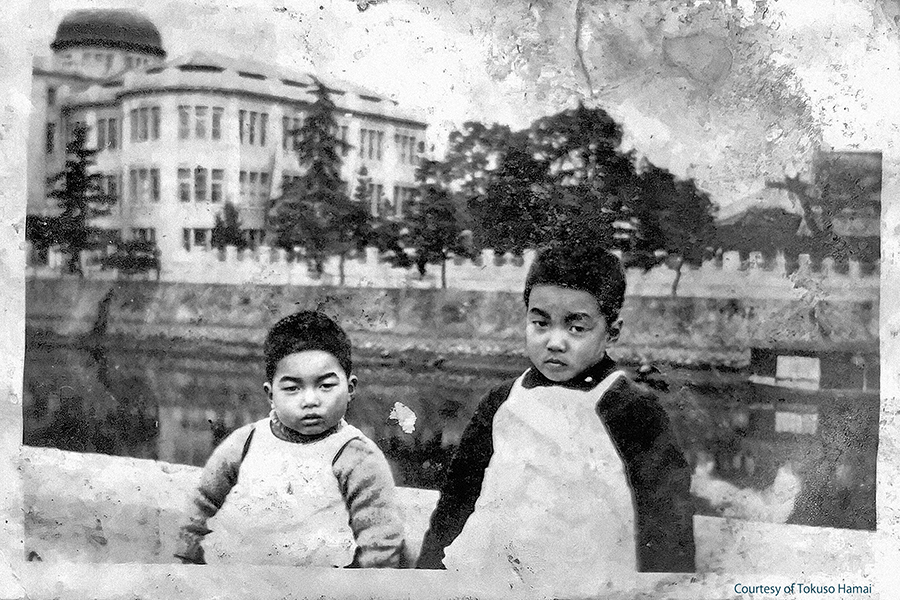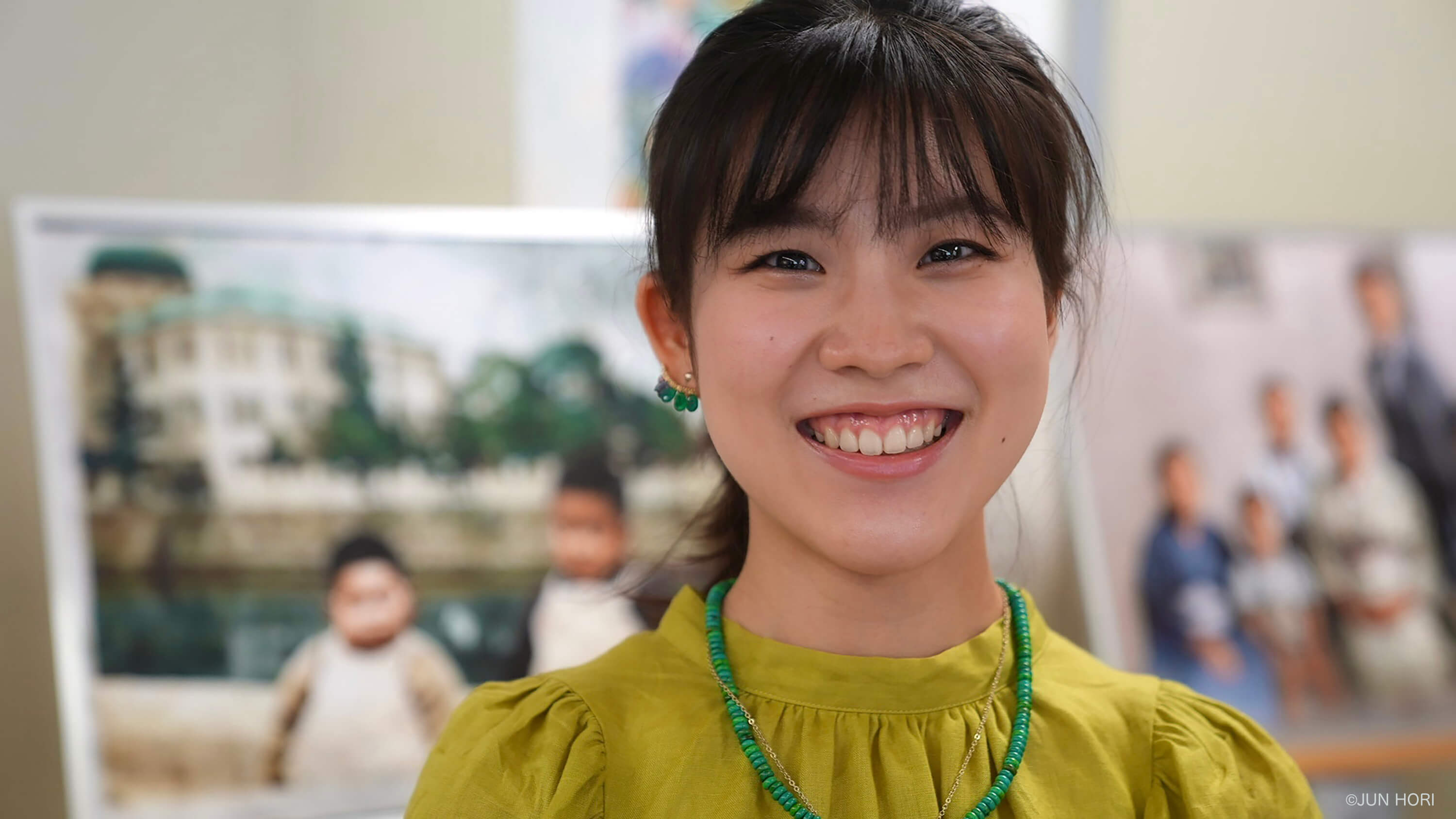-How did you start colorizing photos?
I am from Hiroshima, and my first peace education was in kindergarten. I was very afraid when I saw the devastation after the atomic bombing, and at the time I was not very good at thinking about peace education. However, when I was in the fifth grade of elementary school, the pictures in a brochure I received during our peace education fieldwork changed my mind.
It compares the current Hiroshima Peace Memorial Park with the city before the bombing. Peace Memorial Park used to be a downtown area with approximately 4,400 residents, known as the “Nakajima district.” Daily lives in the area, which are the same as today, were destroyed by a single atomic bomb. I was able to imagine the situation as my own and felt the importance of conveying the message of peace.
It was in my first year of high school that I began to colorize photographs. I joined a peace committee that takes actions for peace including collecting testimonies from atomic bomb survivors. While collecting signatures for the signing of the Treaty on the Prohibition of Nuclear Weapons at the Peace Park, I met Mr. Hamai Tokuso. Mr. Hamai’s family used to run a barber shop in the Nakajima district, and he lost his entire family in the bombing. Mr. Hamai himself was safe because he had been evacuated to a place outside Hiroshima city. A week after meeting Mr. Hamai, I attended a workshop by Professor Watanabe Hidenori at the Graduate School of the University of Tokyo and learned about automatic colorization using AI technology. He created the “Hiroshima Archive,” a collection of videos and documents of A-bomb testimonies on a digital globe on the Internet. Later, when we were recording Mr. Hamai’s testimony, he showed us an album. It contained approximately 250 precious black-and-white daily life photographs of his family before the bombing. I started the project because I wanted to give him an album of colored photos so that he would always feel close to his family.
-What is the process of coloring photos using AI?
First, I combine the images automatically colorized by several AIs, which learned a large number of black-and-white and color images. AIs are good at colorizing natural objects, such as human skin and the sky, but are not as good at colorizing artificial objects, such as clothing. Automatic colorization accounts for only approximately 10% and is only a preliminary colorization. We reproduce the “Color of Memory” through repeated manual color correction by examining materials from the time that time and listening to war survivors’ stories over and over again. This process is time consuming and sometimes takes several months to complete.
For example, in the picture of “Chojuen no hanami”* (cherry blossom viewing at Choju Garden), first, the leaves on the background trees were colored green using AI colorization. However, when Mr. Hamai looked at it, he said, “This was a hanami (cherry blossom viewing) event, so the leaves should be pale pink.” His memories returned one after another. Seeing the lush cedar trees in the photo, he said, “I used to pick cedar nuts and use them as bullets for my cedar gun,” and “I was scared because there was an ammunition depot nearby.” He was pleased and said, “It looks like my family is still alive.” We have come to call this project “Rebooting Memories” because memories that could not be recalled in black-and-white photographs come back vividly in color photographs.
In another case, the person who provided us with the photo “Natsu no danrann”* (Family gathering in summer) had dementia. We were told that it was difficult to communicate with him, but when we showed him the colorized photo, he told us, “I was afraid of the camera’s flash (so I put a watermelon rind on my face).” He talked cheerfully about the other photos as well, as if his memories were “rebooted” one after another. We were happy that his daughter was pleased to see him talking like this.
-What is the goal of the colorization of photographs?
Together with Professor Watanabe, I published a colorized photo book, AI to color-ka shita shashin de yomigaeru senzen senso (Rebooting Memories of Prewar & War Through Colorized Photographs in Collaboration with AI and Human) (Kobunsha Shinsho). The book contains 355 photographs of prewar Japan, including Hiroshima and Okinawa, the beginning of the war, the Pacific War; the Battle of Okinawa, air raids, atomic bombings, and the end of the war. It will also provide an opportunity to think about the theme of this exhibition, “Children and Radiation.”
In addition to photos provided by people from Nakajima district, I visited a newspaper company to find photos from children’s daily perspectives and colorized them.
I wanted to convey the message that war involves not only soldiers on the battlefield but also civilians, including children. War tends to be perceived as a historical event; however, when I think of Mr. Hamai, who was evacuated from his home and left alone without saying goodbye to his family, I feel that war is actually a collection of individual experiences. War survivors have overcome hatred and grief, and wish for peace in the future. The significance of “Rebooting Memories” is to convey their thoughts that “We must never let anyone feel the same way again.”
I believe that mainstream peace education has thus far attempted to convey the tragedy of the atomic bombing of August 6 so that it will never be repeated. However, in the near future, there will be no one who has experienced war in Japan. Young people who have not experienced war cannot understand 100% of the horrors and feelings of those who did. However, we can consider their feelings, pass on their thoughts and memories, and continue to convey them to the next generation.
We are the last generation to hear directly from war survivors; at the same time, this is a precious time when we can convey the importance of peace together with the survivors. We will continue to tell our stories in the hope that this exhibition will inspire people who are distanced from war and peace to take some action.
* Photographs can be seen at the venue.










